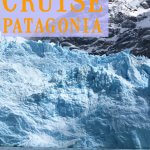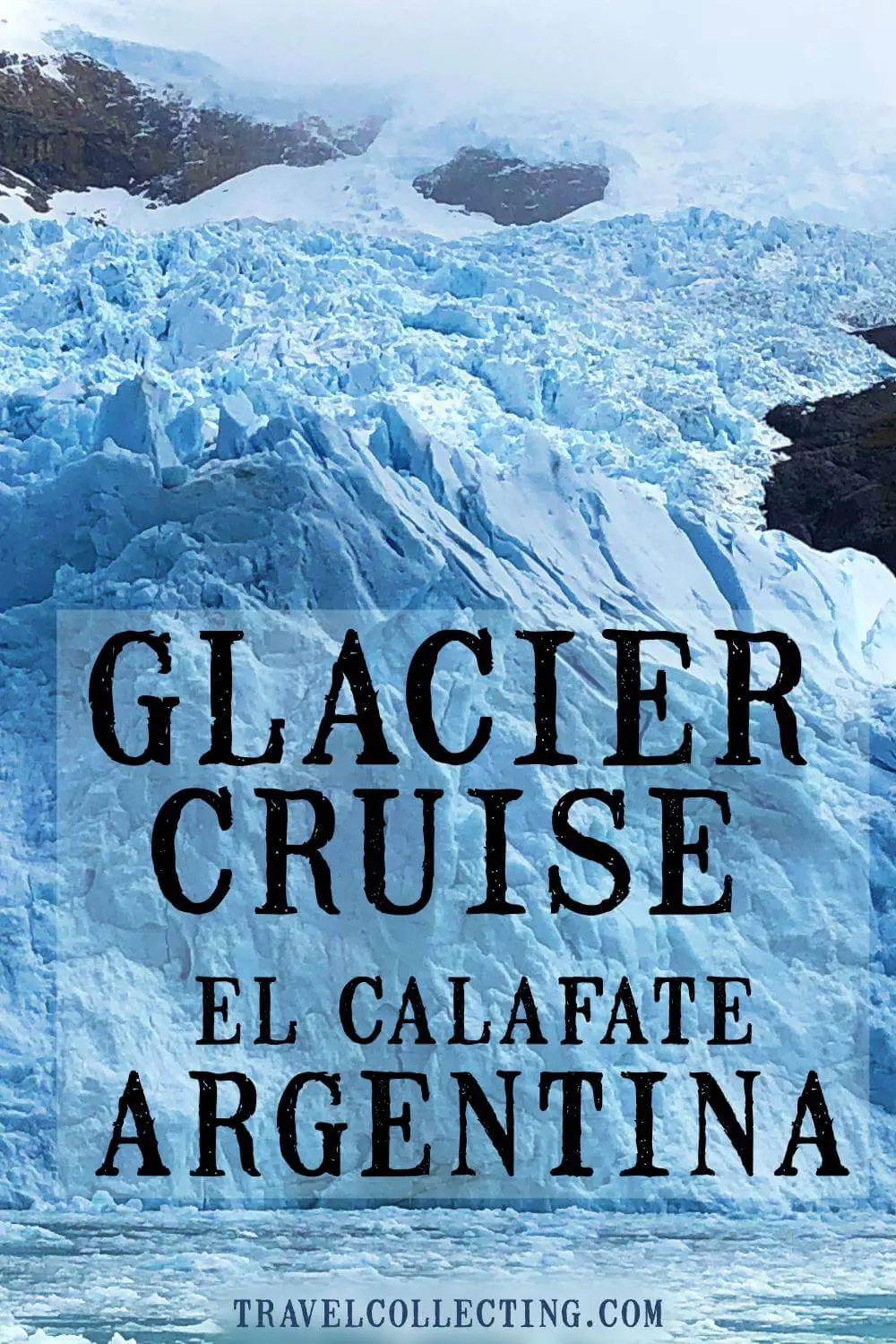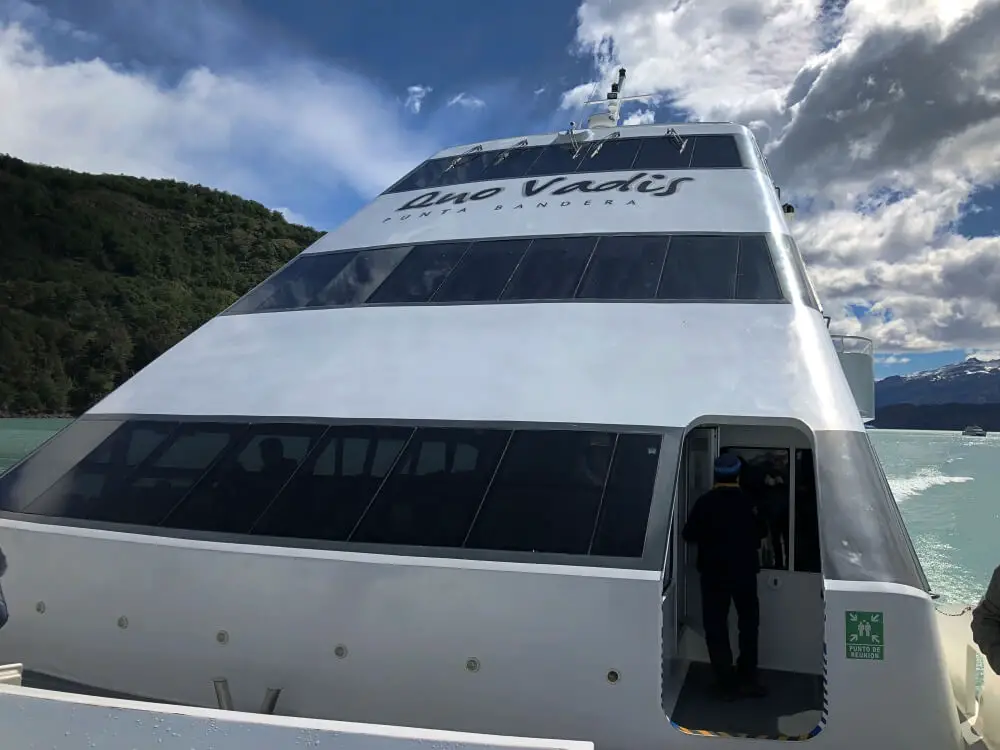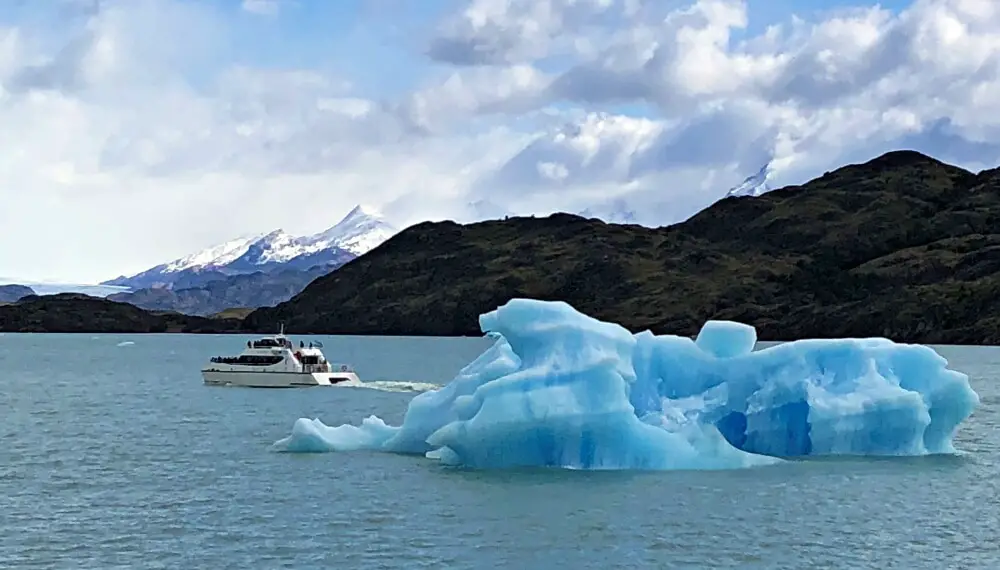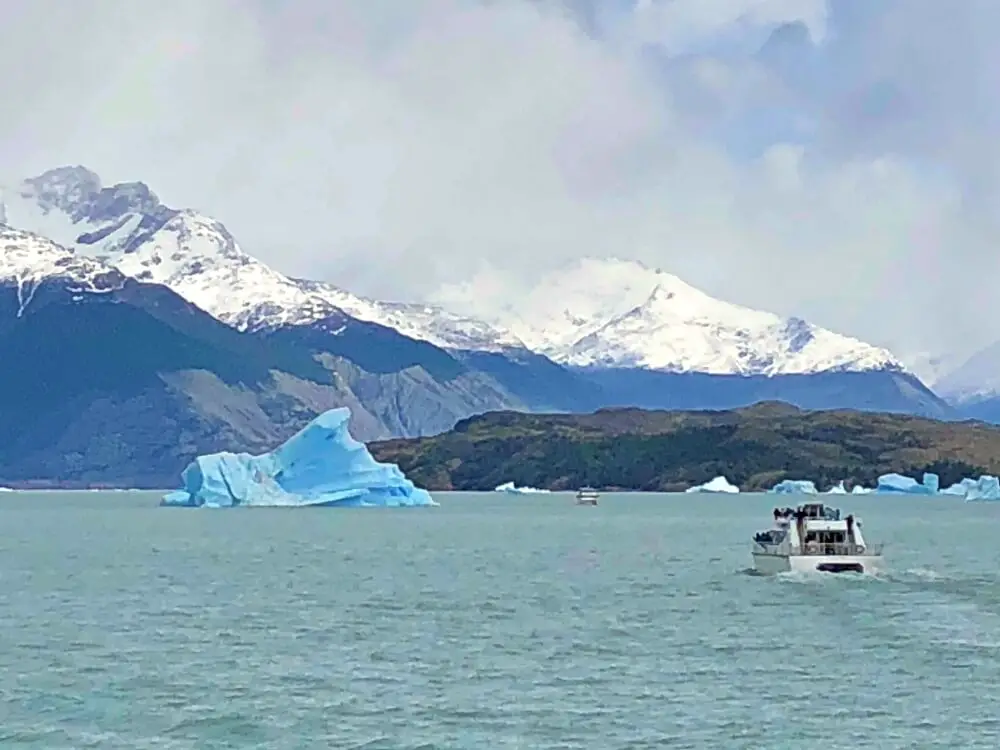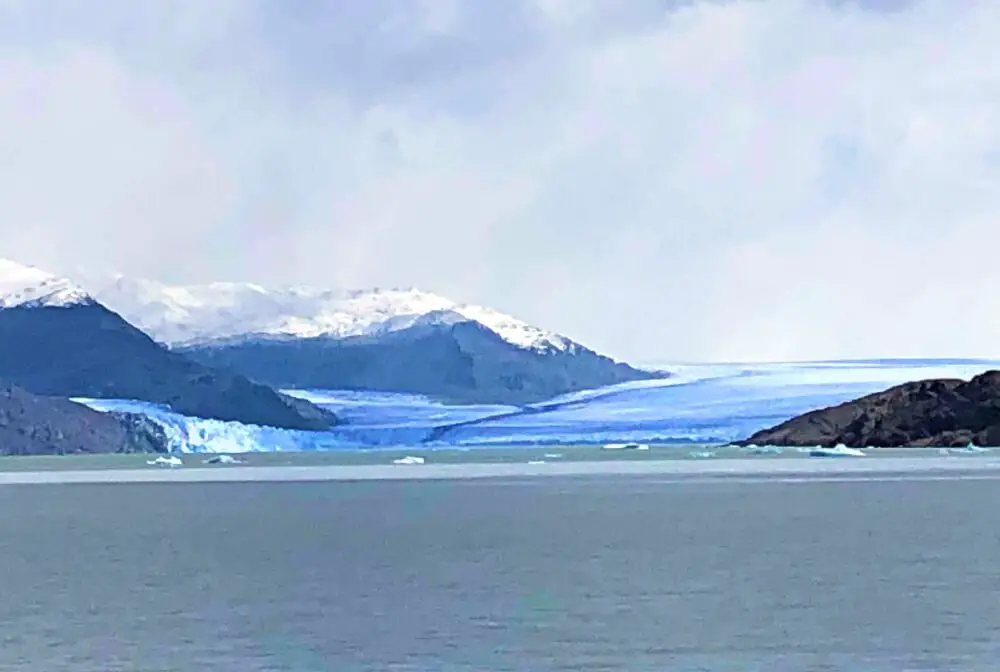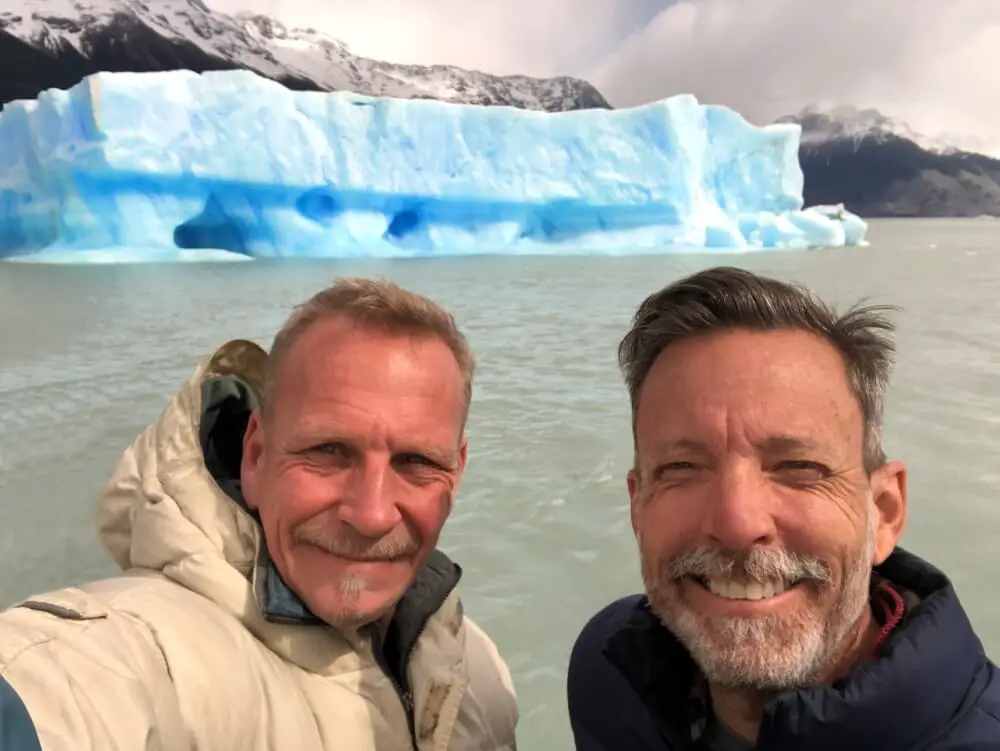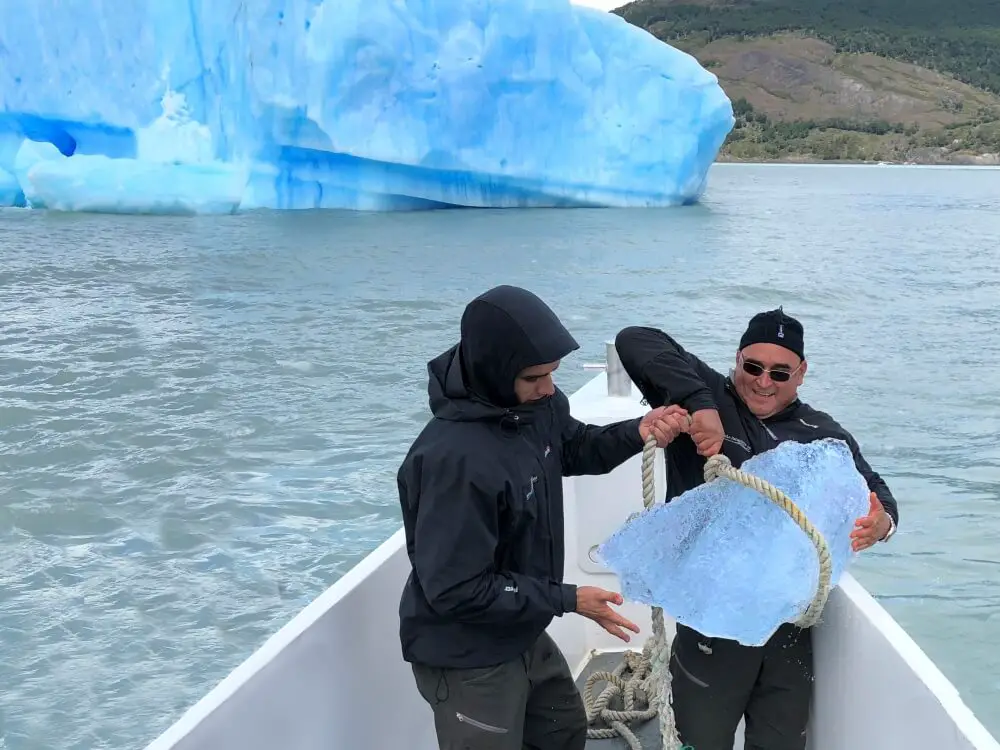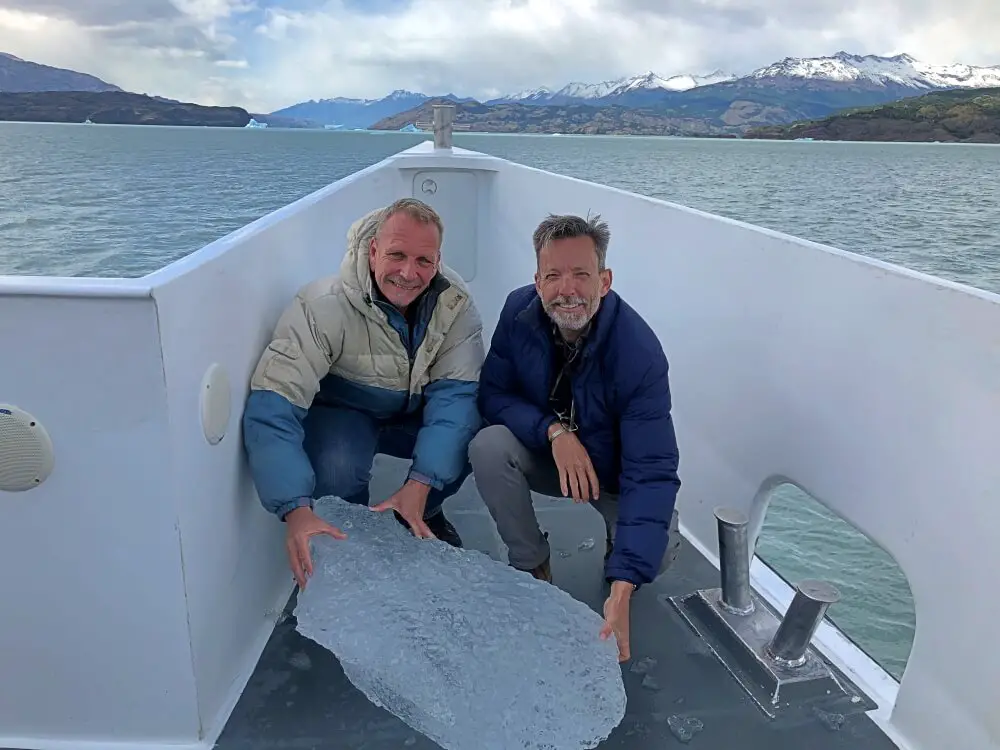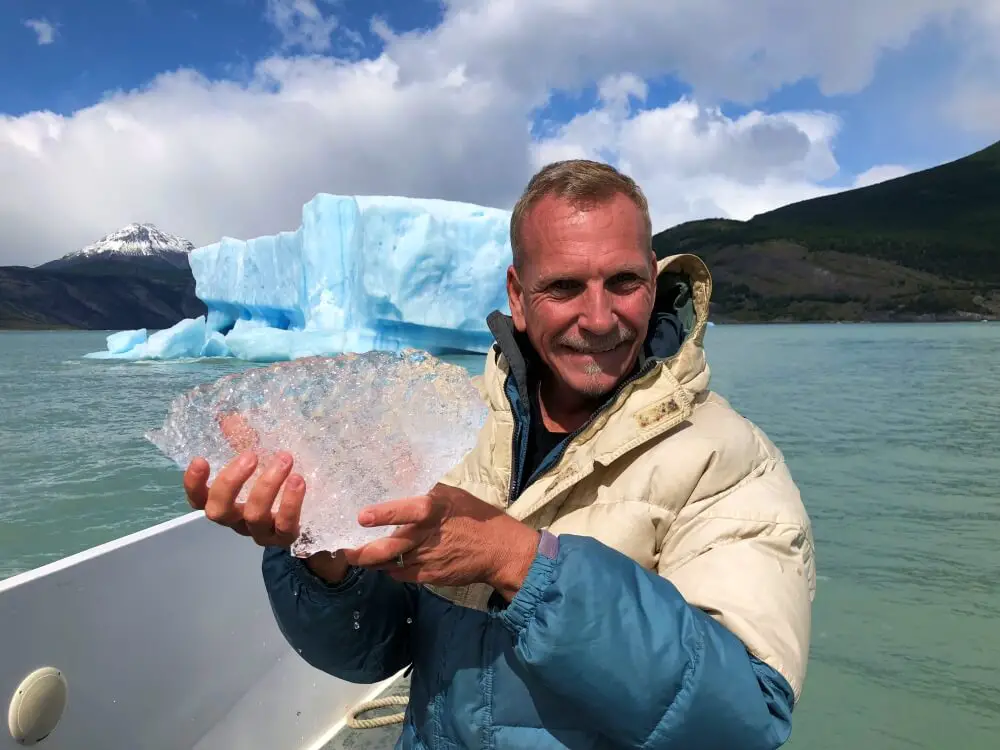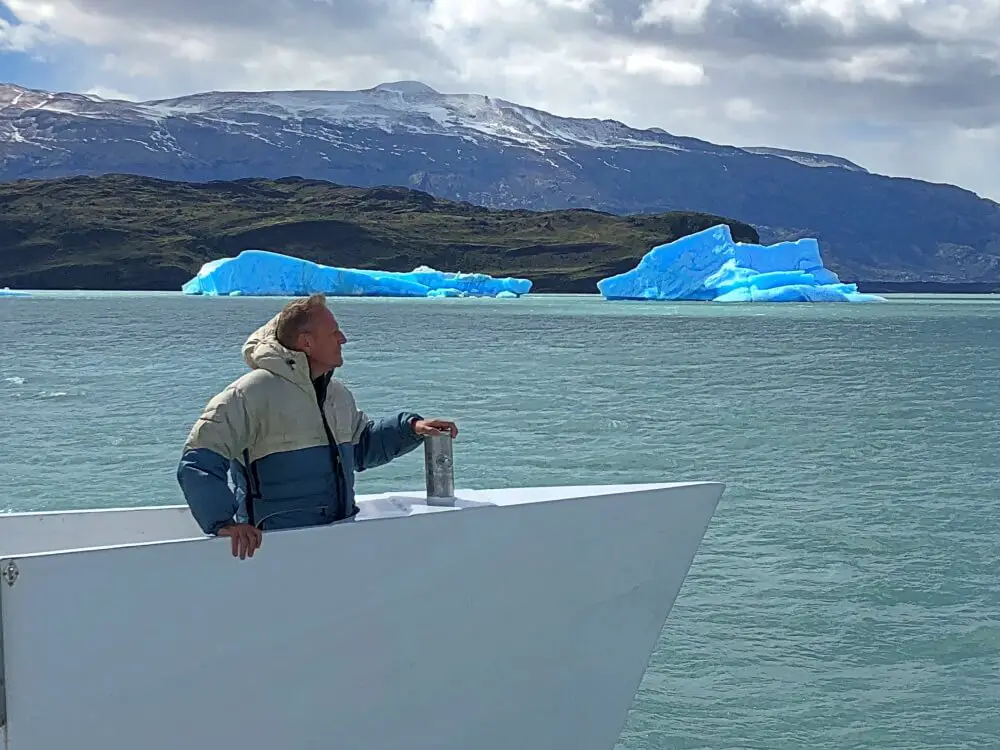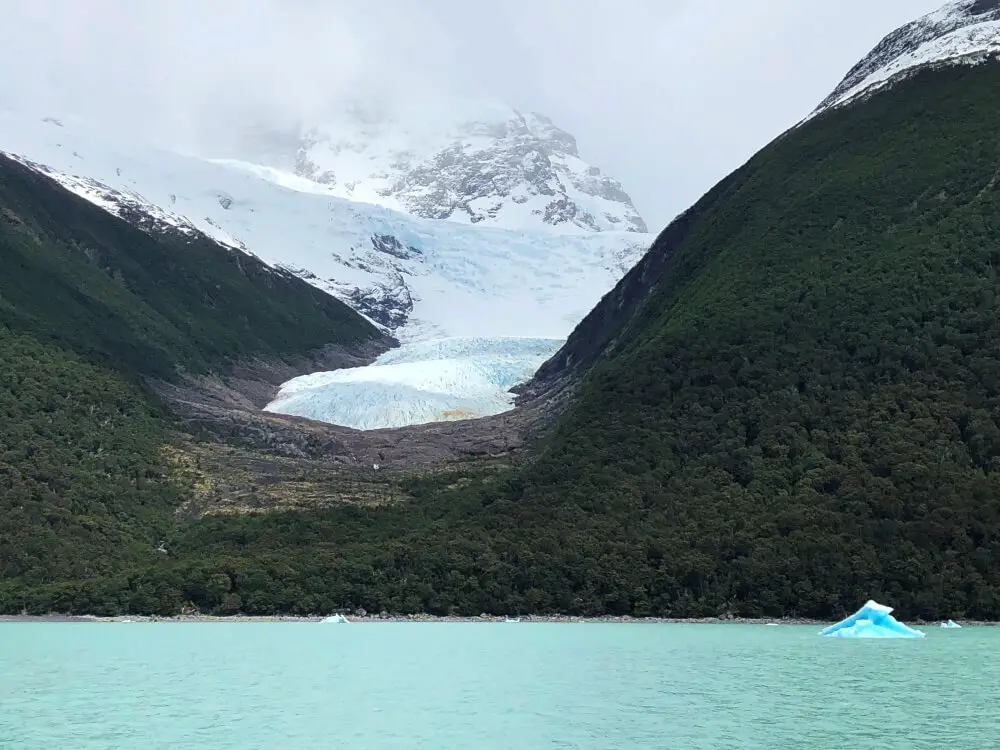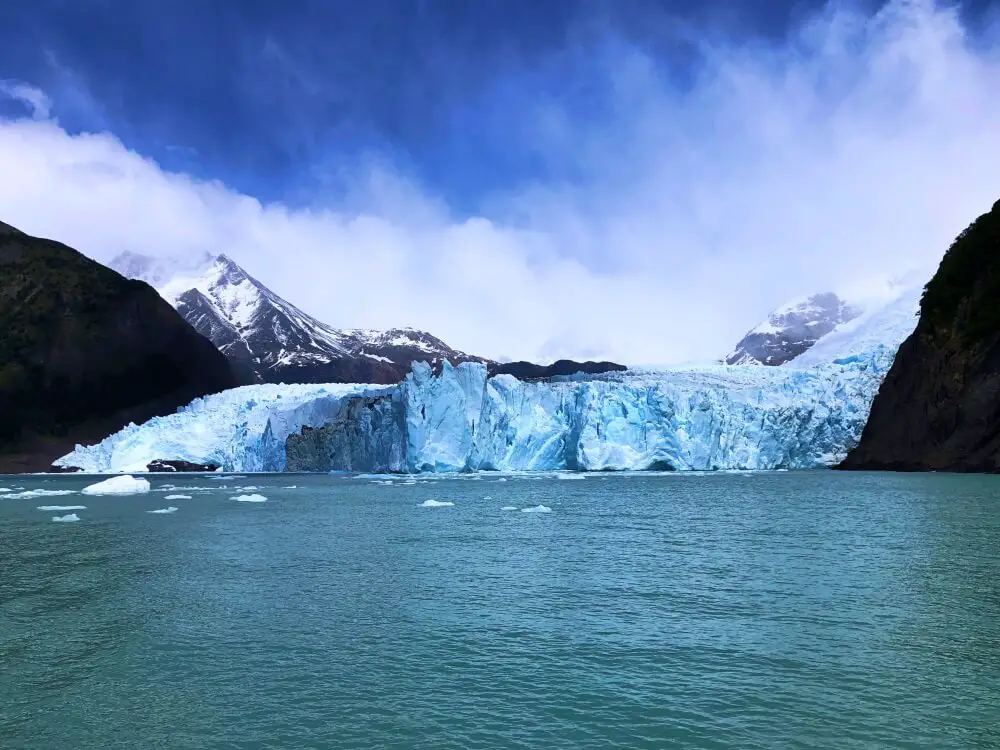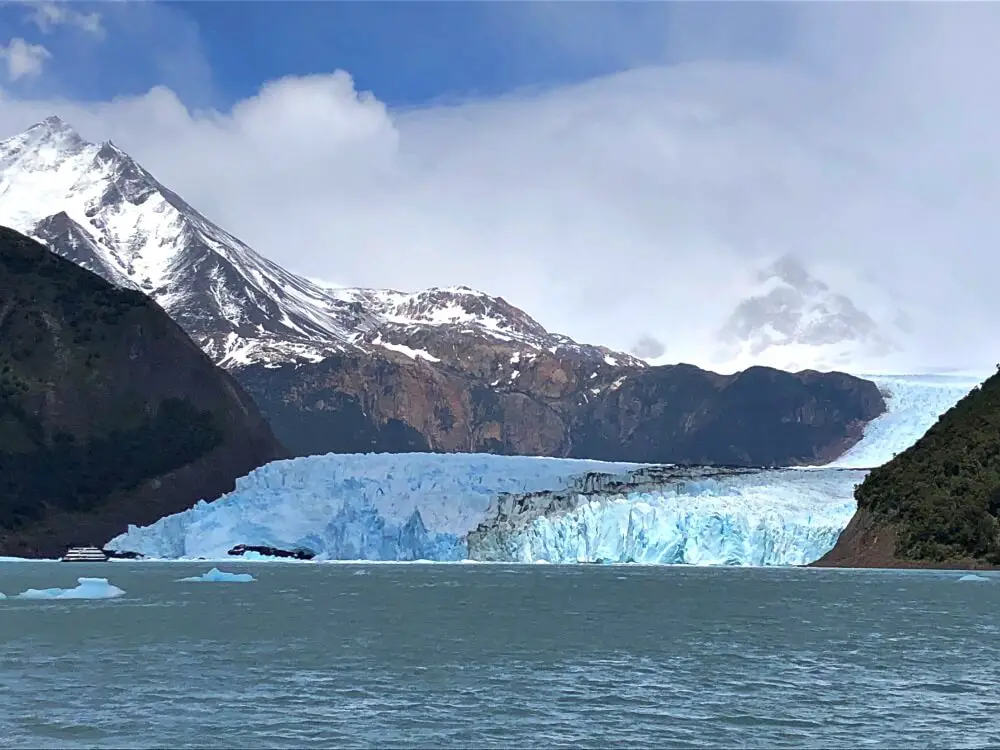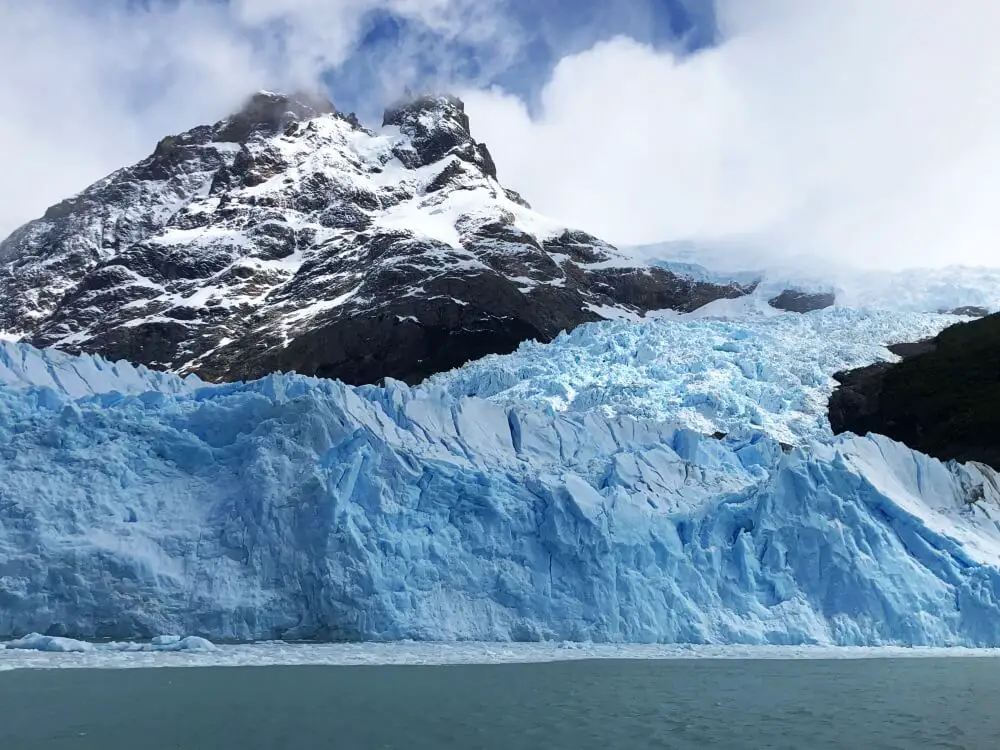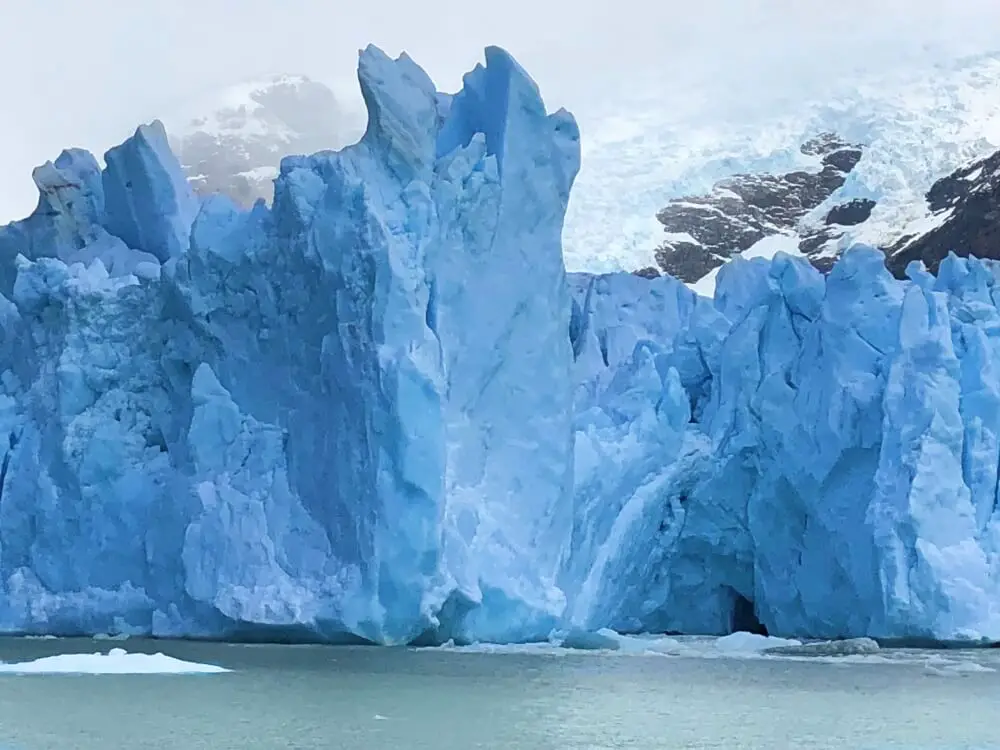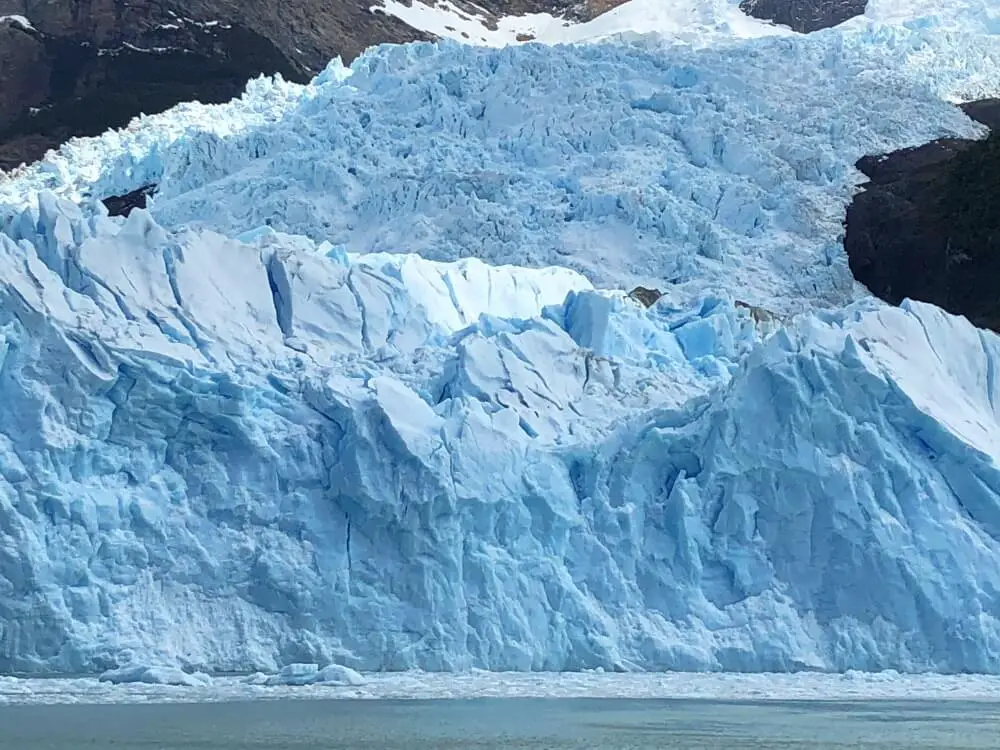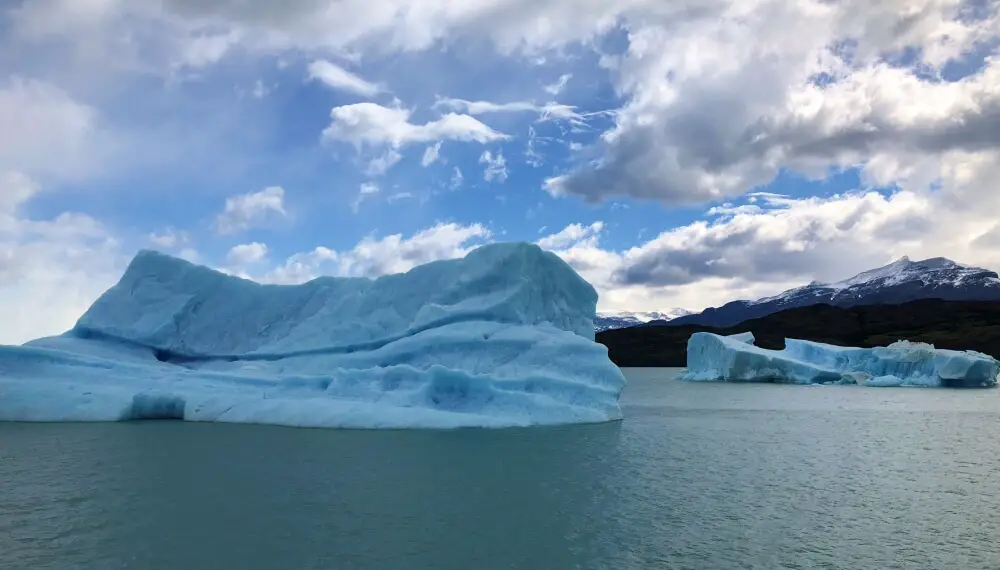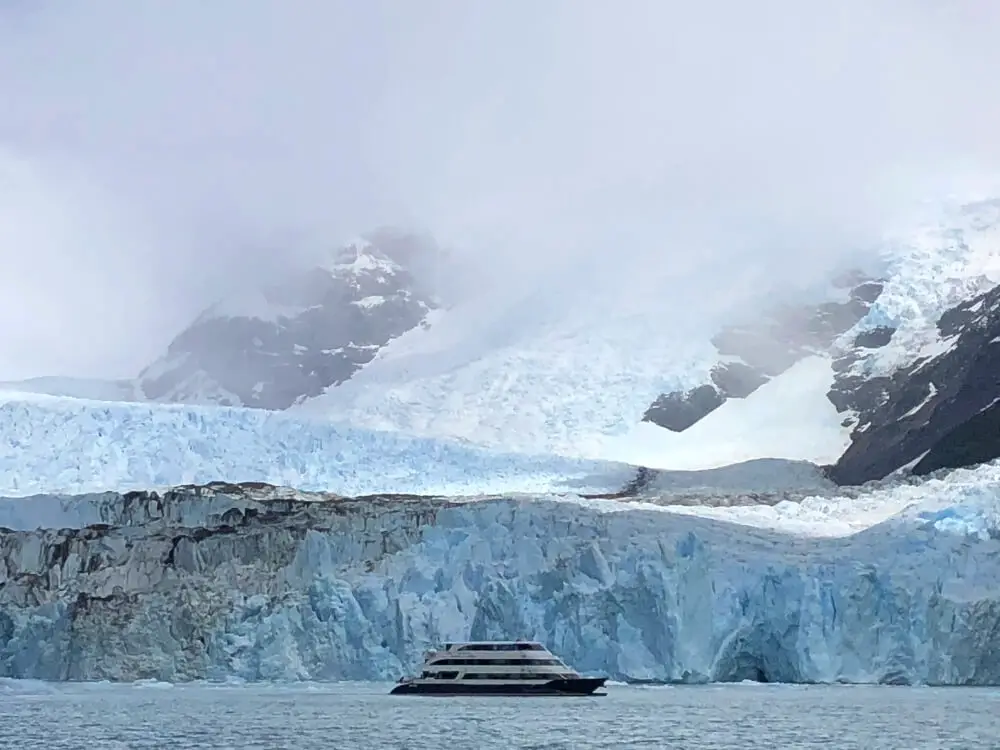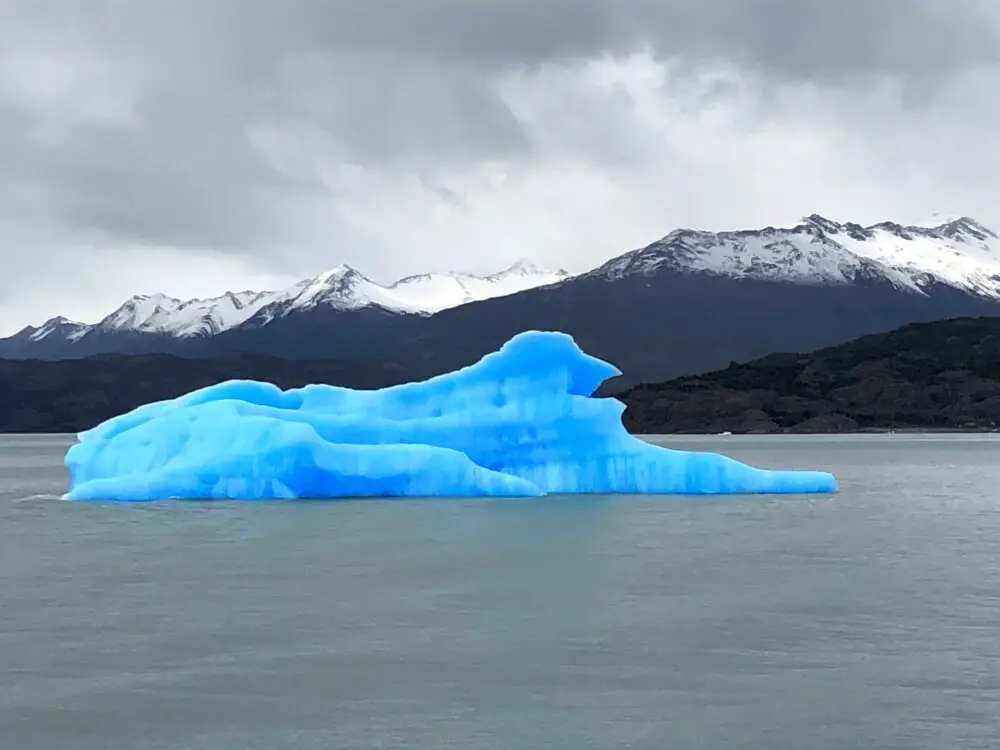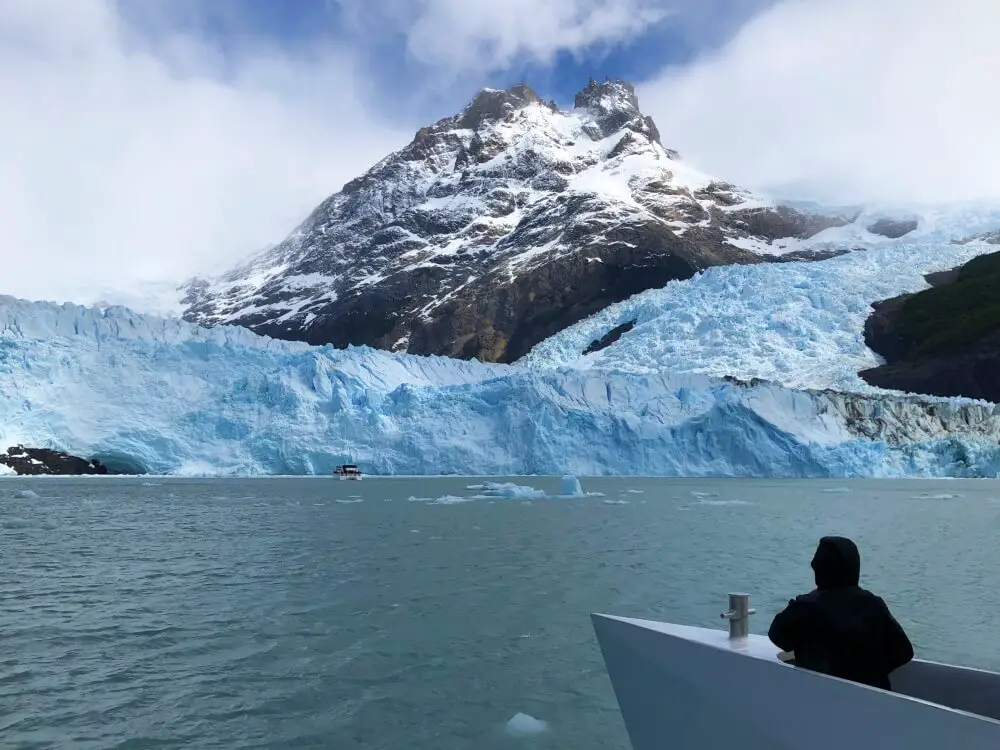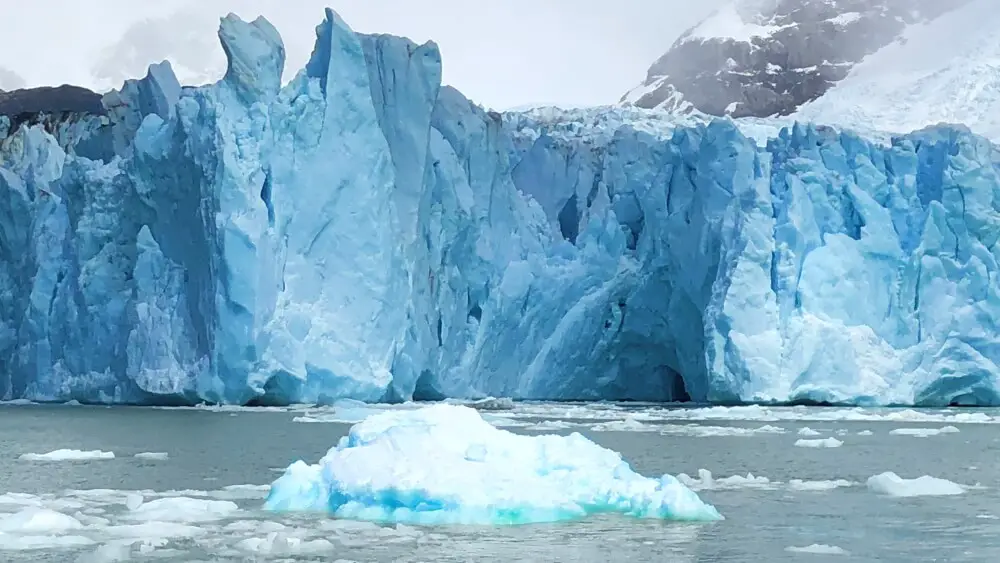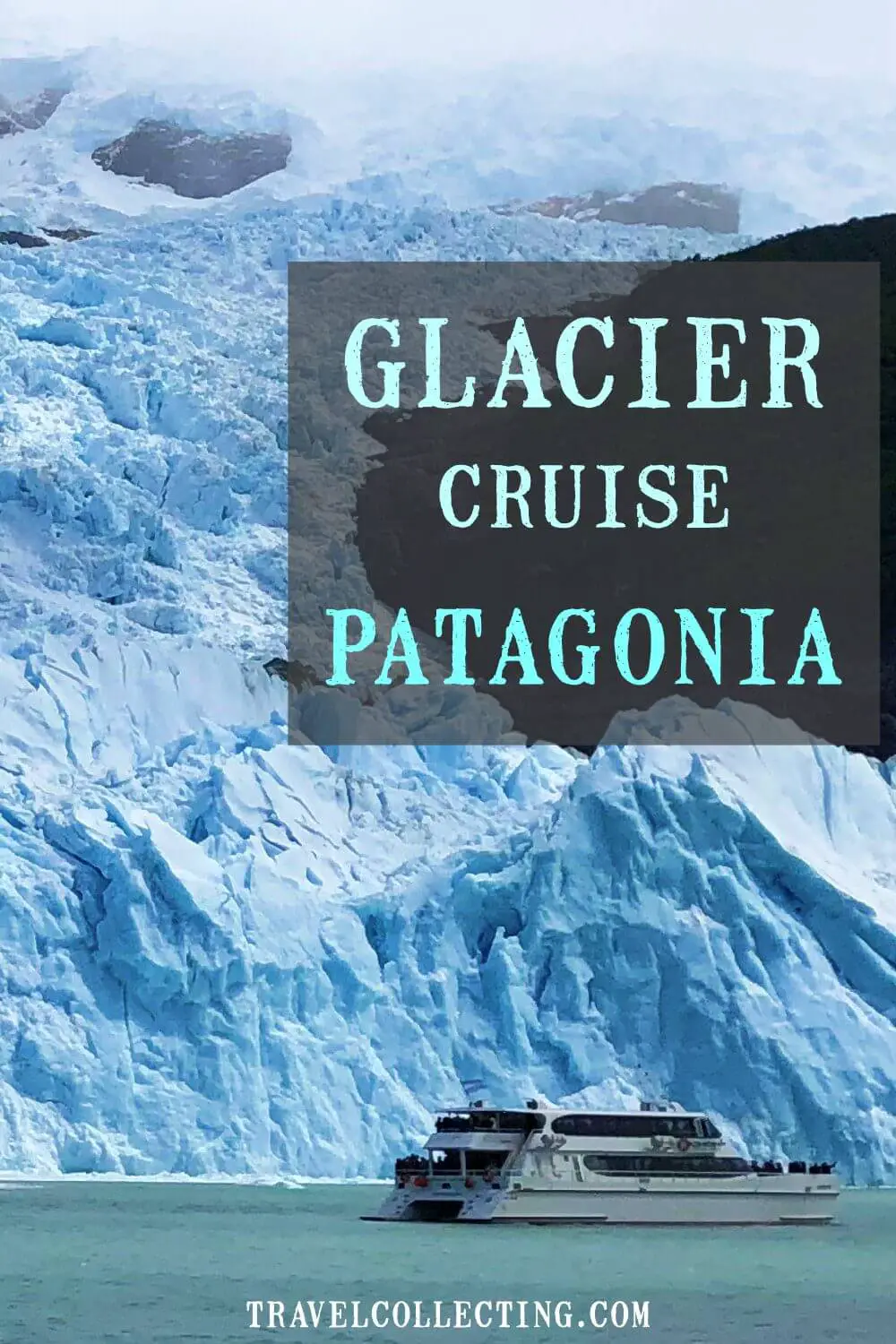A loud crack splits the air. The wall of ice in front of us has shards and towers of blue ice, all precariously attached, until now. Our heads spin, looking to see which part of the glacier will collapse.
A huge chunk of ice breaks off, falling in a puff of icy powder, sliding down into the water and diving below the surface, then erupting back up in a wild leap and splash of water to start its new life as an iceberg.
How cool is this???
No time right now to read about the El Calafate Glacier Tour? Pin it and save it for later:
Please note this post may contain affiliate links, which means we may receive a commission, at zero cost to you, if you make a purchase through a link. Please see our full Disclosure for more information. If you have any questions, please let me know.
INSPIRATION: El Calafate Glacier Tour
I flew to Patagonia from Buenos Aires (you must experience tango when in Buenos Aires – read about it here) for the mountains, icebergs and glaciers. I’m all about having active experiences when travelling, including the awesome Laguna Torre hike in Argentinean Patagonia and being on a boat cruise seems a little passive, but the El Calafate boat tour to the glaciers in Argentina was a chance to get up close and personal with icebergs and glaciers, so it made it on my experiential travel list.
The Lago Argentino cruise visits two of the best glaciers in Patagonia, so I signed up.
Subscribe to monthly updates with tips for planning, travel inspiration and trip ideas and get instant access to the free PDF of this
Review of El Calafate Glacier Tour
Getting to the boat
The day started slowly. We were picked up at 7:00am from hotel. When we arrived at the port about 8:10am there were already several other minivans there, and many more arrived in the next half hour or so, all from different agencies.
The cruise goes through Los Glacieres National Park. Argentina doesn’t charge for hiking in El Chalten, but there is a fee in the El Calafate area. There is a window inside the terminal at which you need to pay the 600 pesos Glacier National Park, Argentina entrance fee. This is separate from the tour price.
A long line snaked through the terminal as we all lined up for the 9:00am boats. Tickets said either Boat A or B, as two different boats left at the same time.
An inauspicious beginning
The start of the cruise was also not very exciting. It was packed, but before we left port, they announced that a separate VIP section with comfy chairs and an open bar was available at the front of the top deck for an upgrade fee. This did help the rest of the boat seem a little less crowded, but I was still eager to do more than sit crammed inside a boat, even if there was a seat free next to me.
Once we finally got started, the catamaran went quite fast and the ensuing spray splattered the side windows and completely covered the front windows, so those in the VIP section saw nothing until we stopped. It also made it impossible to go the front decks while we were moving.
Things pick up: Lago Argentino
However, after it was deemed safe, we were allowed out on to the upper deck, which was sheltered from the wind. Although it was chilly outside, the fresh air was nice and we always prefer to be outside on boats.
Kevin does it because the fresh air helps stave off seasickness. I do it because it makes me feel more alive and connected to the experience than if I am sitting down inside.
We were on Lago Argentino. Patagonia has several glacial lakes, and their color varies. Lago Argentino is bright turquoise out by the airport and the road to El Chalten, but the part on the Lago Argentino boat trip is a milky grey-blue color.
The color comes from “rock flour”. Rock flour is a white powder that is formed by a glacier as it scrapes the ground below it as it slowly moves. The dust ends up in the water, creating the milky color.
We passed through the narrowest part of the lake, the Boca del Diablo (Devil’s Mouth) and continued up past several oddly shaped icebergs.
Upsala Glacier, Argentina
After about 1 hour and 15 minutes, we stopped about 7.5 miles/ 12 km from Upsala Glacier for a “panoramic view” of the glacier i.e. you could see it in the distance.
Some interesting facts about Upsala Glacier, Patagonia:
- A glacier is an ice river that is formed by the compression of snow over hundreds of years.
- Upsala Glacier, El Calafate is named after the Swedish Uppsala University, who sponsored one of the first studies of the glacier.
- It is one of 47 glaciers in the Glacier National Park El Calafate area. They are all connected to the Southern Patagonian Ice Field, which is the third largest body of fresh water on the planet after Antarctica and Greenland.
- Upsala Glacier is the largest glacier in South America. How big is the Upsala Glacier? It is:
- Area: 336 square miles/ 870km²
- Length: 37 miles/ 60km
- Width: 6 miles/ 10 km
- Height: 230 feet/ 70m
- Although Upsala Glacier still moves forward, the glacier is actually retreating rapidly (like 90% of the glaciers in Patagonia and Antarctica). It has retreated 2 miles/ 3km since 2001.
- The front (called the snout or foot) of the glacier does not actually touch the ground/ bottom of the lake. As the glacier moves forward, the overhang gets longer, until it falls off (calves) all at once.
- When 6 miles/ 10km width of ice falls off all at once, there is a huge surge and a lot of new icebergs are born. This makes it dangerous for any boat to get close to the glacier, which is why the Upsala Glacier cruise boat tours stay far away and you only get a “panoramic” view of the glacier.
Although the glacier is only visible in the distance, it is possible to get a sense of its enormity.
It creates plenty of icebergs, and we stopped near a large rectangular, very blue iceberg. The other catamarans we saw stopped near different icebergs, so we never felt like we were in a crowd of boats.
Icebergs
Icebergs are born when chunks of ice calve/ break off from the front of glaciers as they slowly march forward.
The boat stopped for quite a while, while everyone had their photo taken by the ship’s photographers at the front of the boat with the iceberg as a backdrop.
After the photos were done and most people were back inside sitting down, the crew dragged up a huge chunk of ice tied with a rope, and swung it onboard.
Then one of the crew members took a long ice spear and stabbed it, breaking it into smaller pieces that could be easily carried.
These were then chopped into even smaller pieces and used as ice cubes in drinks that were sold at the bar.
So, you could have a pisco sour with ice cubes hundreds of years old.
Spegazzini Glacier, Argentina
We started up again, going more slowly, so that it was possible to stand outside at the front.
The 30-minute ride to Spegazzini Glacier took us past the land-locked Glacier Seco (Dry Glacier) on the right.
Spegazzini Glacier slowly appeared at the end of the lake tumbling down hillside far above us, and ending in a slowly-revealed wall of ice.
Some facts about Spegazzini Glacier:
- How big is the Spegazzini Glacier? It is
- Area: 51.7 square miles/ 134 km2
- Length: 10.5 miles/ 17 km
- Width: 0.80 miles/ 1.3 km
- Height: 440 feet/ 135 meters
- Depth: 492 feet/ 150 meters
- Unlike most glaciers in South America (the world), it is fairly stable. Between 1968 and 2010, the ice front only retreated 492 feet/150m.
- The glacier sits on the ground, so, although it calves a lot, it doesn’t calve all at once, which makes it safe to go close to the face of the glacier.
We were able to get about 650 feet/ 200m away from the glacier. It flows down the side of a mountain between a rocky outcrop and the side of a peak, into the lake.
We cruised slowly from the left side all along the face of the glacier to the right. The glacier groans and cracks constantly as it shifts and settles.
The boat stopped at a vantage point for the obligatory photo taken by the ship’s photographers. Again, this was easy to ignore, as the face of an enormous glacier was a very short distance away, right in front of us.
We saw two parts of the glacier calve, which was very cool.
Although these cruises are mostly touted as an Upsala Glacier tour, this was by far my favorite part of the cruise. Seeing the glacier from below up so close was incredible. Spegazzini may not be the largest glacier, but it is incredibly picturesque, framed by a snowy jagged peak and seeing it is definitely one of the best things to do in El Calafate, Argentina.
Heading back
At 12:30pm, we started to head back. I didn’t want to leave, as I was totally enthralled by the glacier, but all good things have to end.
On the way back, we ate our lunch (we had bought a boxed lunch through our hotel, but there is a small bar with some food onboard) as we passed more icebergs.
We arrived back at port at 2:00pm and were at our hotel by 3:00pm.
Map of the El Calafate glaciers cruise
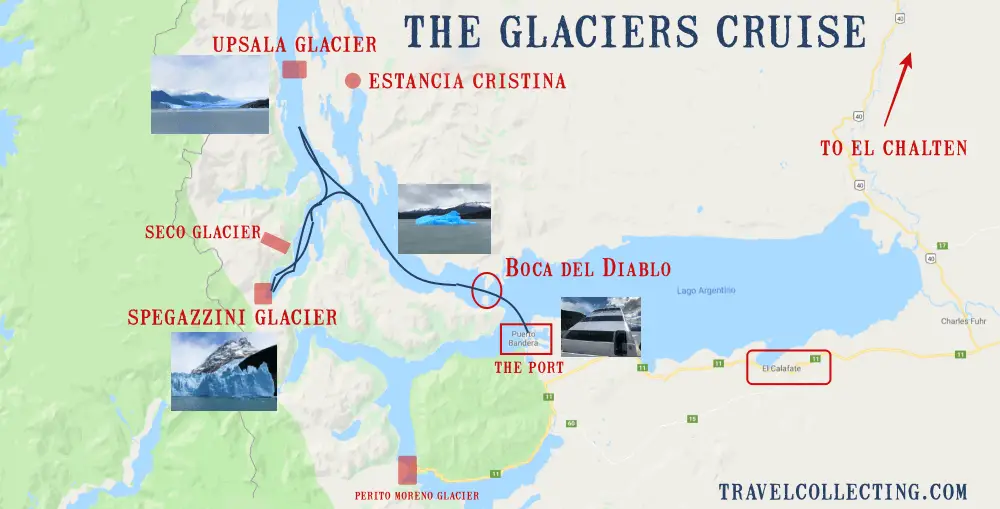
The verdict: El Calafate cruise of the glaciers
The hotel pick up/ drop off was not only painless, but also convenient. I usually don’t like this, as it can end being a tour of all of the local hotels, but the minivan was small and the hotels virtually on the way from town to Puerto Bandera, where the boat left from.
I was a little dubious at the start, to be honest, as we were younger than most on the boat, but you could stay inside and be comfortable or be outside in the chilly wind and feel more involved, which is what we did.
A lot of the cruise was spent with people having their photos being taken, but it was possible to ignore this and just enjoy the views. The bright blue icebergs and the up close and personal Glacier Spegazzini were spectacular and really that’s what made this cruise one of the best things to do in El Calafate, Patagonia.
Subscribe to monthly updates with tips for planning, travel inspiration and trip ideas and get instant access to the free PDF of this
Review of El Calafate Glacier Tour
How to book the El Calafate glacier boat tour
The El Calafate cruise is one of the top things to do in El Calafate and every agency can book you on the cruise. However, it is popular, so I recommend booking in advance. You can book it here.
It includes pick up and drop off at your hotel anywhere in El Calafate, which is not a very big town.
Guide to Visiting El Calafate
Where is El Calafate and what is the currency?
El Calafate is in Patagonia, the southern region of South America. It is the northern end of southern Patagonia, and because it has an airport, is a major gateway to Patagonia. El Calafate is 220 kilometers south of El Chalten and 280 kilometers north of Puerto Natales.
It is in Argentina, and the currency is the Argentinean peso. Check the current exchange here.
Spanish is the official language in Argentina, though El Calafate is a tourist town, so you could probably get by pretty easily with English.
Best time to visit El Calafate
The best – and most popular – time to visit El Calafate is January to mid-March, when it is warmest. However, this is also when it is most crowded, so if you prefer to have the glaciers a little more to yourself, spring and fall/ autumn have fewer tourists and the weather can still be nice. I was there in late November and although there were some windy days (not the day of this glacier cruise though), it was very pleasant.
El Calafate weather
| Month | Average High | Average | Average low |
| January | 67.7°F/ 19.8°C | 58.9°F/ 14.9°C | 45.4°F/ 7.4°C |
| February | 66.6°F/ 19.2°C | 57.6°F/ 14.2°C | 44°F/ 6.7°C |
| March | 63.7°F/ 17.6°C | 54.2°F/ 12.3°C | 40.4°F/ 4.7°C |
| April | 56.7°F/ 13.7°C | 46.9°F/ 8.3°C | 33.1°F/ 0.6°C |
| May | 48.9°F/ 9.4°C | 40°F/ 4.4°C | 28.7°F/ -1.8°C |
| June | 44.6°F/ 7°C | 35.7°F/ 2.1°C | 26°F/ -3.3°C |
| July | 42.8°F/ 6°C | 33.8°F/ 1°C | 23.9°F/ -4.5°C |
| August | 45.4°F/ 7.4°C | 36.8°F/ 2.7°C | 26.1°F/ -3.3°C |
| September | 52.2°F/ 11.2°C | 42.4°F/ 5.8°C | 30°F/ -1.1°C |
| October | 57.2°F/ 14°C | 47.4°F/ 8.6°C | 34.6°F/ 1.4°C |
| November | 61.2°F/ 16.2°C | 51.7°F/ 10.9°C | 38.8°F/ 3.8°C |
| December | 65.1°F/ 18.4°C | 56.2°F/ 13.4°C | 43.5°F/ 6.4°C |
Season weather in El Calafate breakdown
| Spring | Summer | Autumn/ Fall | Winter | |
| Hours of Daylight | 12 to 16 hours | Up to 17 hours of daylight in December and January | Up to 13 hours | Up to 10 hours |
| Rainfall | Average four days per month | Average three days per month | At least seven days of rainfall in May (the wettest month) | Heavy snowfall |
| Wind | Average speeds of 13.2 mph. 21.2km/h* in November (the windiest month). | Still windy. Wind speeds up to 12.7 mph/ 20km/h | 3.6 mph/ 5.8km/h in May, the lowest wind speeds of the year | wind speeds of up to 4.5 mph/ 7.2km/h |
* For reference: Hurricane force winds are officially 74 mph/ 118 km/h or greater. This is an average – wind speeds in Patagonia can get up to 100 mph /160 km/h and literally blow you off your feet.
Upsala weather is unpredictable and it’s not uncommon to experience wind, snow, rain and sunshine all in one day – even in summer.
Getting to El Calafate
Getting to Patagonia takes time, as it very far away from basically everywhere. The main gateway city in Argentina from other international places is Buenos Aires. When in Buenos Aires, make sure to experience tango (read all you need to know about tango here). If you are entering Patagonia in Chile and then coming to El Calafate, the main international gateway is Santiago, Chile. Check out posts on Chile here.
So, how to get to El Calafate from Buenos Aires? There are three main ways to travel from Buenos Aires to Patagonia: by plane, by bus and by car.
How to get to Patagonia from Buenos Aires by plane
El Calafate Airport is just outside town, and is the main Patagonia airport. There are direct flights daily to and from Buenos Aires (3.5 hours), Ushuaia (1.5 hours), and Bariloche (1.75 hours).
Compare prices on flights to El Calafate with Skyscanner.
Getting to El Calafate by Bus
Major bus routes to/ from El Calafate include:
- Rio Gallegos, southwest of El Calafate, in Argentina. 4 hours
- El Chalten, north of El Calafate, in Argentina. 3 hours.
- Buenos Aires, the capital of Argentina. Change buses in Bariloche. 5 hours to Bariloche.
- Bariloche, in the lake district in northern Patagonia, Argentina. 5 hours.
- Puerto Natales, south of El Calafate, in Chile. 5-7 hours, including border crossing.
Click here for bus schedules and tickets.
Buy a shared transfer from El Calafate to El Chalten here.
Getting to El Calafate by car
For directions to drive from Rio Gallegos, click here. 3.5 hours.
For directions to drive from Buenos Aires, click here. 32 hours (via Rio Gallegos).
For directions to drive from Puerto Natales in Chile, click here. 3.5 hours plus border crossing.
For directions to drive from El Chalten, click here. 3.5 hours.
Note that there are not that many gas stations in Patagonia, so always, always fill up when you can. For more information on driving distances and gas stations, read my Guide to Driving in Patagonia.
Book a transfer between El Calafate Airport and your hotel here.
Book a private transfer between El Calafate Airport and your hotel here
How to get from El Calafate airport to town and getting around El Calafate and Patagonia
There are a couple of options for getting from El Calafate airport to town.
El Calafate airport transfer
The easiest option is to take a private transfer from the airport into town. Book a private transfer here.
The other option is a bus. Ves provides an airport shuttle from El Calafate airport to your hotel/ hostel in town, for all flights. It costs $300 pesos from the airport to your hotel or $450 pesos both ways. You need to pay in cash, so make sure you have cash. There is an ATM at the airport, but is is often out of order, so come with cash if you can. Book the shuttle here.
Car rental at El Calafate airport
You can get around Patagonia by bus, but for more freedom, renting a car is the way to go. This is what we did, and it meant we could stop on the side of the road to take photos of animals. Rent a car here.
Before you rent a car, check out my Guide to Driving in Patagonia for tips, driving distances, information on gas stations and much more.
Where to stay in El Calafate, Argentina
There are lots of hostels and hotels in El Calafate to choose from. Many of the hostels are a little upscale. I also like staying in boutique hotels, as they have more character than chain hotels.
For tips on what to look for, check out my Guide to Choosing a Hotel.
Hostels in El Calafate
America Del Sur Calafate Hostel
I don’t often stay in hostels anymore (though I used to all the time), but stayed at the America Del Sur Calafate Hostel to save money and it was great. We had our own room in the “house”, a small building off the main building with just two rooms. The hostel has a nice vibe, super friendly staff, a cheap and enormous parilla barbecue dinner (and wine) and a (for purchase) packed lunch. Breakfast is included. It’s not right in the center of town, but is only about a 10-minute (uphill) walk from the main drag. Book the America del Sur Calafate Hostel here.

Folk Hostel
Also highly recommended on Booking.com. Book the Folk Hostel here.
Boutique Hotels in El Calafate
Patagonia Queen Hotel
This has a Booking.com rating of 9.4. it’s in a beautiful wooden building and rooms have private whirlpool bathtubs. There’s a game room and a bar, plus breakfast. Book the Patagonia Queen Hotel here.

Hotel La Cantera
A designer lodge with floor-to-ceiling windows in the lounge. Book the La Cantera hotel here.
El Calafate things to do
If you’re wondering what to do in El Calafate and how long to spend in El Calafate, well, I would recommend a few days at least in order to experience most of the El Calafate attractions. There’s a lot on offer in and around El Calafate.
What to do in El Calafate, Argentina depends somewhat on how adventurous you are, but there is something for everyone. I recommend visiting the Glacarium – the Glacier Museum – for an interesting insight into glaciers. Buy tickets to the Glacarium, including a transfer from/ to town here (it is a little out of town).
Find top El Calafate tours and other experiences here.
Planning and packing for Patagonia
There is so much to see in Patagonia, you will want to plan your trip carefully. I used the Lonely Planet and Moon travel guides, in addition to the Internet. Buy the Argentina Lonely Planet here and buy Moon’s Patagonia guidebook here.
Follow my Trip Planner to stake the stress out of planning your trip.
When you are ready for your trip, check out my Essential Packing List.
Travel Insurance for Patagonia
Some of the El Calafate activities are more relaxed like this cruise, but others like ice trekking are higher risk. However, no matter which of the El Calafate day trips you do, you should still get travel insurance. Read my guide to buying travel insurance if you are unsure of what to look for.
A great insurance option is Travelex. It has coverage for all you’ll need. You can swap this link for either compare Travel Insurance plans here or get a quote right now:
Subscribe to monthly updates with tips for planning, travel inspiration and trip ideas and get instant access to the free PDF of this
Review of El Calafate Glacier Tour
Enjoy the glaciers!
Do you have any stories of El Calafate or Patagonia? I’d love to hear them. Comment below.
If you liked this post, Pin it to your Patagonia board for later!
Read more posts about Patagonia:
- Experiencing Perito Moreno Glacier in Argentina
- Hiking to Cerro Torre, Argentina
- Hiking French Valley in Patagonia, Chile
- Where to stay in Torres del Paine NP, Chile
- Driving in Patagonia (Argentina and Chile)
- Taking a food tour in Santiago, Chile
- Tasting wine in the Maipo Valley, Chile
- Experiencing tango in Buenos Aires, Argentina
If you like day cruises, you will also like taking a cruise through the Rhine Gorge in Germany
About the author

James Ian has traveled to 83 countries and all 7 continents. He is passionate about experiential travel, i.e. meaningful travel that actively engages with the environment and culture. He helps people have similar experiences that involve active participation in activities and festivals; engaging with the local food and handicrafts through lessons and food tours; and interacting positively with environment by hiking, riding, rowing, diving and low/no impact animal encounters.
Travel Collecting is a participant in the Amazon.com Services LLC Associates Program. As an Amazon Associate I earn from qualifying purchases.

